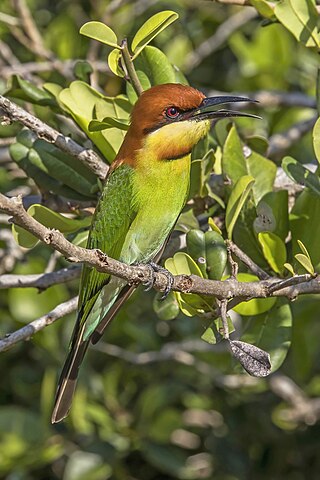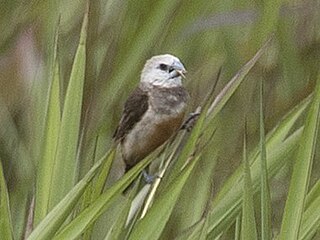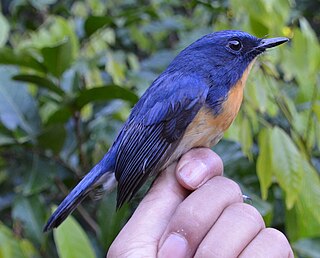
The chestnut-headed bee-eater, or bay-headed bee-eater, is a bird in the bee-eater family Meropidae. It breeds on the Indian subcontinent and adjoining regions, ranging from India, Bangladesh and Sri Lanka across Southeast Asia to Indonesia.

The bronze mannikin or bronze munia is a small passerine bird of the Afrotropics. This very social estrildid finch is an uncommon to locally abundant bird in much of Africa south of the Sahara Desert, where it is resident, nomadic or irruptive in mesic savanna or forest margin habitats. It has an estimated global extent of occurrence of 8,100,000 km2. It is the smallest and most widespread of four munia species on the African mainland, the other being black-and-white, red-backed and magpie mannikin. It co-occurs with the Madagascar mannikin on the Comoro Islands, and was introduced to Puerto Rico. Especially in the West Africa, it is considered a pest in grain and rice fields. It is locally trapped for the pet bird trade.

The chestnut munia or black-headed munia is a small passerine. It was formerly considered conspecific with the closely related tricoloured munia, but is now widely recognized as a separate species. This estrildid finch is a resident breeding bird in Bangladesh, Brunei, Cambodia, China, India, Indonesia, Laos, Malaysia, Burma, Nepal, the Philippines, Singapore, Taiwan, Thailand, Vietnam and Hawaii. It also has been introduced to all the Greater Antilles and Martinique in the Caribbean.

The slaty spinetail or slaty castlebuilder,, is a passerine bird in the Furnariinae subfamily of the ovenbird family Furnariidae. It is found from Honduras south to Peru.

The African firefinch, also called the blue-billed firefinch, is a common species of estrildid finch found in many parts of Africa. It has an estimated global extent of occurrence of 5,400,000 km2 (2,100,000 sq mi).

The grey-banded mannikin, or grey-banded munia, is a species of estrildid finch known to be found in Anggi Gigi, Tamrau Mountains, and Arfak Mountains in the Vogelkop Peninsula in north-western Papua, Indonesia. This species inhabits mid-mountain wet grassland and marshland. It also can be found on abandoned agricultural plots near human settlements.

The chestnut-breasted mannikin, also known as the chestnut-breasted munia or bully bird, is a small brown-backed munia with a black face and greyish crown and nape. It has a broad ferruginous breast bar above a white belly. The species is found in Australia, New Caledonia, Indonesia, and Papua New Guinea. This species has also been introduced to French Polynesia.

The eastern (pale) chanting goshawk, or Somali chanting goshawk, is a bird of prey of East Africa.

The tricoloured munia is an estrildid finch, native to Bangladesh, India, Sri Lanka, Pakistan, and southern China. The species has also been introduced to the Caribbean, in Trinidad, Jamaica, Hispaniola, Puerto Rico, Cuba, and Venezuela. This species, like the chestnut munia has been known as the black-headed munia. Immature birds have pale brown upperparts, lack the dark head found in adults, and have uniform buff underparts that can be confused with immatures of other munias such as the scaly-breasted munia.

The black-crested coquette is a species of hummingbird in the "coquettes", tribe Lesbiini of subfamily Lesbiinae. It is found in Belize, Costa Rica, Guatemala, Honduras, Mexico, and Nicaragua.

The moustached kingfisher, also called Bougainville moustached kingfisher, is a species of bird in the family Alcedinidae. It is endemic to Bougainville Island in Papua New Guinea. An estimated 250–1,000 mature individuals are left.

The cordilleran canastero is a species of bird in the Furnariinae subfamily of the ovenbird family Furnariidae. It is found in Argentina, Bolivia, Chile, and Peru.

The grey-throated leaftosser is a Near Threatened species of bird in the subfamily Sclerurinae, the leaftossers and miners, of the ovenbird family Furnariidae. It is found in Bolivia, Brazil, Colombia, Costa Rica, Ecuador, Panama, Peru, Trinidad and Tobago, and Venezuela.

The ruddy spinetail is a species of bird in the Furnariinae subfamily of the ovenbird family Furnariidae. It is found in Bolivia, Brazil, Colombia, Ecuador, Guyana, Peru, Suriname, Venezuela, and possibly Guyana.

The rufous-rumped antwren is a species of bird in subfamily Euchrepomidinae of family Thamnophilidae, the "typical antbirds". It is found in Colombia, Costa Rica, Ecuador, French Guiana, Guyana, Panama, Peru, Suriname, and Venezuela.

The pale-tailed canastero, is a species of bird in the Furnariinae subfamily of the ovenbird family Furnariidae. It is endemic to Peru.

The blue-throated hillstar is a hummingbird found only in a small portion of the southwestern Andes in Ecuador. It was discovered in 2017.

The Meratus blue flycatcher is a species of bird in the Old World flycatcher family, Muscicapidae. The species was described in 2021 by the Indonesian ornithologist Mohammed Irham and his colleagues, based on genetic, morphological, and vocal differences with other Cyornis flycatchers. It is endemic to the Meratus Mountains of Indonesian Borneo, where it has been recorded only from Mount Besar. It is most common at elevations between 900 and 1,300 m and inhabits montane rainforest, secondary forest, and rubber plantations. It is sexually dimorphic like other species in its genus; males have blue upperparts, iridescent blue patches on the forehead and shoulders, and orange-and-white underparts, while females have gray-brown heads and upperparts. They have a length of 15.7–16.0 cm (6.2–6.3 in); males weigh 18.5–19.75 g (0.653–0.697 oz) and females weigh 15.75–20.0 g (0.556–0.705 oz).



















